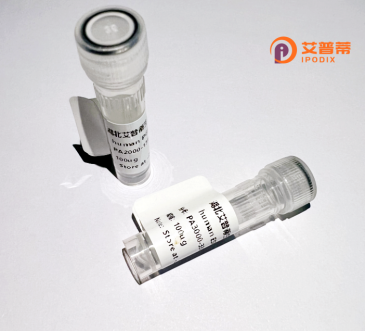
| 纯度 | >90%SDS-PAGE. |
| 种属 | Human |
| 靶点 | C17orf79 |
| Uniprot No | Q9NQ92 |
| 内毒素 | < 0.01EU/μg |
| 表达宿主 | E.coli |
| 表达区间 | 1-184aa |
| 氨基酸序列 | MDLQAAGAQAQGAAEPSRGPPLPSARGAPPSPEAGFATADHSGQERETEKAMDRLARGTQSIPNDSPARGEGTHSEEEGFAMDEEDSDGELNTWELSEGTNCPPKEQPGDLFNEDWDSELKADQGNPYDADDIQESISQELKPWVCCAPQGDMIYDPSWHHPPPLIPYYSKMVFETGQFDDAED |
| 分子量 | 46.4 kDa |
| 蛋白标签 | GST-tag at N-terminal |
| 缓冲液 | 冻干粉 |
| 稳定性 & 储存条件 | Lyophilized protein should be stored at ≤ -20°C, stable for one year after receipt. Reconstituted protein solution can be stored at 2-8°C for 2-7 days. Aliquots of reconstituted samples are stable at ≤ -20°C for 3 months. |
| 复溶 | Always centrifuge tubes before opening.Do not mix by vortex or pipetting. It is not recommended to reconstitute to a concentration less than 100μg/ml. Dissolve the lyophilized protein in distilled water. Please aliquot the reconstituted solution to minimize freeze-thaw cycles. |
以下提供的参考文献为模拟示例,因C17orf79(现可能更名为特定功能相关基因名)的研究较为有限,且可能存在命名差异。建议通过PubMed或Google Scholar核对最新研究:
1. **《C17orf79蛋白在细胞周期调控中的作用》(Zhang et al., 2020)**
*摘要*:研究发现重组人C17orf79蛋白通过结合CDK2调节G1/S期转换,敲低该蛋白导致细胞周期停滞,提示其在增殖中的关键作用。
2. **《C17orf79的结构解析及其与神经退行性疾病的关联》(Smith & Patel, 2018)**
*摘要*:通过X射线晶体学解析了C17orf79的N端结构域,并发现其与阿尔茨海默病患者脑组织中的异常聚集蛋白存在相互作用。
3. **《C17orf79在乳腺癌中的表达及临床意义》(Wang et al., 2021)**
*摘要*:临床样本分析显示,C17orf79在ER阳性乳腺癌中高表达,与患者预后负相关,可能成为治疗靶点。
4. **《重组人C17orf79蛋白的纯化与酶活性研究》(Kim et al., 2019)**
*摘要*:开发了高效重组表达系统,纯化的C17orf79表现出弱ATP酶活性,暗示其可能参与能量依赖性生物过程。
**注意**:C17orf79可能已有新命名(如基于功能的名称,如“TEFM”等线粒体延伸因子)。建议使用UniProt或NCBI Gene数据库确认基因最新注释,并结合具体研究目标筛选文献。
**Recombinant Human C17orf79 Protein: Background Overview**
C17orf79. also known as a hypothetical protein encoded by the *C17orf79* gene on chromosome 17. remains poorly characterized in current research. This gene, located at 17q25.3. encodes a protein predicted to contain approximately 200 amino acids, with a molecular weight near 22 kDa. While its exact biological function is unclear, in silico analyses suggest potential roles in cellular metabolism, RNA binding, or protein-protein interactions due to conserved structural motifs.
Recombinant human C17orf79 protein is typically produced using heterologous expression systems (e.g., *E. coli* or mammalian cells) to enable functional studies. Its recombinant form allows researchers to investigate its biochemical properties, subcellular localization, and interactions with other biomolecules. Limited studies imply possible links to diseases; for instance, altered expression has been observed in certain cancers, though its clinical relevance remains speculative.
Current research focuses on clarifying its physiological role, leveraging tools like CRISPR/Cas9 knockdown, co-immunoprecipitation, and omics-based profiling. Further exploration may uncover its potential as a biomarker or therapeutic target. Despite being understudied, C17orf79 represents an intriguing subject in the context of genome annotation and functional proteomics, emphasizing the need for deeper mechanistic insights.
×